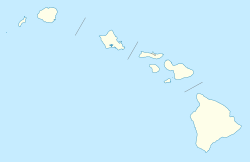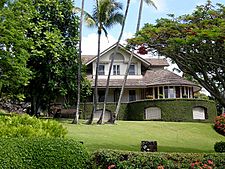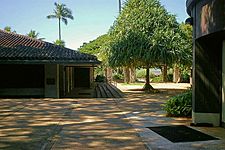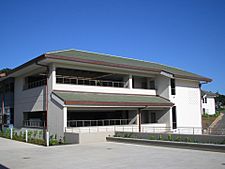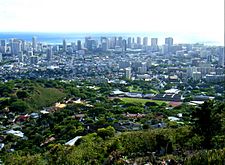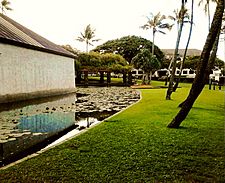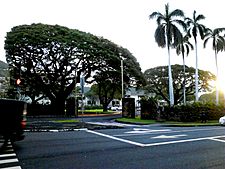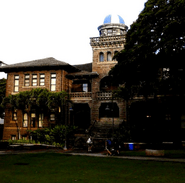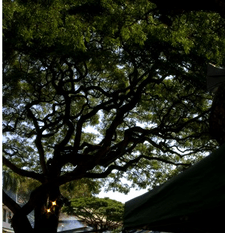Punahou School facts for kids
Quick facts for kids Punahou School |
|
|---|---|
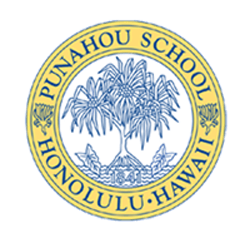
The center of the seal depicts a hala tree rooted on a spring with kalo on either side. Two night-blooming cereus flowers, which border the campus, are found on the seal's outer ring.
|
|
| Address | |
|
1601 Punahou Street
, 96822
United States
|
|
| Information | |
| Type | Private, college-prep, day |
| Religious affiliation(s) | Christian (Nondenominational) |
| Established | 1841 |
| President | Mike Latham '86 |
| Faculty | 300+ |
| Grades | K–12 |
| Gender | Coeducational |
| Number of students | 3,000+ (approx.) |
| Campus type | Urban |
| Color(s) | Buff and Blue |
| Athletics conference | Interscholastic League of Honolulu (ILH) |
| Team name | "Buffanblu" colloquially "Puns" or "Buff 'n Blue" |
| Rivals | Kamehameha, Iolani |
| Publication | Literary magazines: Kakela (6-8) Ka Wai Ola (9-12) |
| Newspaper | Ka Punahou |
| Yearbook | Na ʻOpio (K-8) The Oahuan (9-12) |
|
Punahou School Campus
|
|
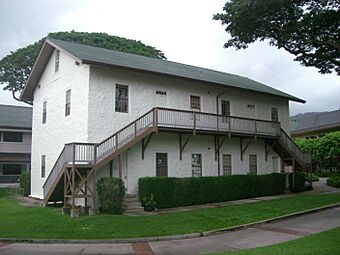
Old School Hall, built in 1851
|
|
| Built | 1842 |
| NRHP reference No. | 72000419 |
| Added to NRHP | August 7, 1972 |
Punahou School is a private school in Honolulu, Hawaii. It's a "college-prep" school, meaning it helps students get ready for college. Both boys and girls attend Punahou, from kindergarten all the way through 12th grade. Over 3,700 students go here, making it one of the largest independent schools.
Punahou was started in 1841 by Protestant missionaries. It aims to give students a well-rounded education. In 2006, it was named the greenest school in America. In 2017, its sports program was ranked second best in the country by MaxPreps Cup. Students come from many different backgrounds. They are chosen based on their schoolwork and other talents.
Contents
Punahou School's History
How Punahou's Land Was Given
In 1795, King Kamehameha I won the land known as Ka Punahou in a battle. He gave about 225 acres of land, including Ka Punahou, to Chief Kameʻeamoku. This was a reward for Kameʻeamoku's loyalty. After the chief passed away, the land went to his son, Ulumāheihei Hoapili. Hoapili lived there for 20 years. When he moved to become governor of Maui, he gave the land to his daughter, Kuini Liliha.
Liliha and her husband, Oahu Governor Boki, then gave Ka Punahou to Reverend Hiram Bingham. He was one of the first Protestant missionaries in Hawaii. Queen Kaʻahumanu supported the mission. She even built a stone wall to protect her house nearby from wild cattle. Part of this wall is still there today.
Starting the School for Missionary Children
Punahou School first opened for the children of missionaries. These missionaries worked all over the Pacific region. It was the first school west of the Rocky Mountains and east of Asia to teach only in English. The very first class was held on July 11, 1842. It had 15 students. Daniel Dole was Punahou's first principal.
Punahou has taught members of the Hawaiian royal family. However, it is not the same as the Royal School. From 1853 to 1934, Punahou was known as Oahu College.
Punahou During World War II
During World War II, the U.S. Army Corps of Engineers took over much of the Punahou campus. Castle Hall, which used to be a girls' dorm, became a command center. Buildings were connected by tunnels. Athletic fields were used for parking cars. The library was cleared out for sleeping and eating areas for officers. The cactus hedge around campus even got barbed wire on top.
Punahou students helped out during the war. They volunteered in hospitals. They also raised enough money to buy two bombers and a fighter plane. These planes were named after former students who had died serving their country.
Later Years and Historic Status
In the 1970s, Punahou's upper field and gym were used for the "Superstars" TV sports competitions. On August 7, 1972, the campus was added to the National Register of Historic Places listings in Oahu. This means it is recognized as an important historical site.
School Traditions and Events
Many special events happen at Punahou School each year.
Punahou Carnival
Every February, the junior class hosts the Punahou Carnival. This happens on the first Friday and Saturday of the month. The money raised from the carnival helps fund the school's Financial Aid program. This event is a big highlight for entertainment in Honolulu.
Holoku Pageant
The Holoku Pageant is a yearly event that celebrates Hawaiian culture and arts. Students perform traditional Hawaiian dances. These include the beautiful hula and the powerful haka. They wear traditional costumes for their performances.
Sustainability Fair
The annual Sustainability Fair started in 2007. It includes challenges on campus to save resources. It also involves efforts to protect the coastline away from school. Classes set up booths on Rice Field. They show off projects about sustainable living. Often, they sell local produce and hand out information.
Flaming P and Spirit Week
To celebrate the school's homecoming, students and teachers gather around a 20-foot letter P. They light it up at dusk. This event is called the "Flaming P." Before this, there's a spirit week. Students dress up and parade in creative ways.
Senior Year Events
Seniors write and perform a Variety Show. Most of the class, over 300 students, take part in this play. Seniors also have their prom at the Sheraton Waikiki Hotel. They have a "Skip Day" at the Kikila Estate and Pounders Beach. There is also a special senior lunch.
Senior year ends with baccalaureate ceremonies at Central Union Church. Then, commencement takes place at Stan Sheriff Center. For these events, boys wear blue blazers and girls wear formal white Hawaiian dresses.
Thirteen Plus Club
Students who started Punahou in kindergarten and graduate from there are part of the Thirteen Plus Club.
Alumni Luau
In June, the school hosts an Alumni Luau on campus. The newly graduated class can enjoy this event with other former students. This annual luau also helps raise money for the school.
Dress Code and G-Term
For most of Punahou's history, elementary students could attend school bare feet. Aloha shirts were once only allowed on Fridays. But the dress code became more relaxed in the 1970s.
G-Term is a special week after winter break. Students can explore extra activities. They can choose from classes on or off the island.
School Location and Learning Opportunities
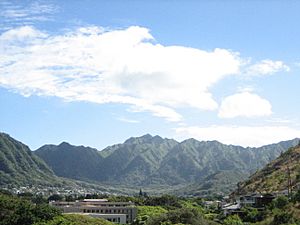
Punahou School is located in a city area of Honolulu. Other buildings nearby include apartments, houses, a retirement home, and hospitals. It shares the entrance to Manoa Valley with the University of Hawaii and other schools.
Punahou students are close to many interesting places. These include the trail to Manoa Falls, the beaches at Ala Moana and Waikiki, and downtown Honolulu.
The school's location offers many chances for learning outside the classroom. Middle school students go on field trips to places like the Bishop Museum and Waikiki Aquarium. They also visit Iolani Palace and the USS Arizona Memorial. Clubs and classes often take trips to other islands. They especially visit Hawaii Volcanoes National Park on the Big Island.
Punahou School Today
Tuition and Financial Aid
For the 2023–24 school year, tuition was $30,480. This amount does not include student activity fees. Tuition does not cover the full cost of educating each student. The school's special fund, called an endowment, helps make up the difference. In 2014, Punahou's endowment was $239 million. Other schools in Hawaii, like Iolani School and Kamehameha Schools, also have large endowments.
College Admissions and Student Achievements
Punahou graduates go on to many different colleges. In the class of 2015, 22 students went to Ivy League schools. These include Harvard, Princeton, and Yale. Many also chose schools like Stanford, MIT, and Boston University. Some students even went to universities in other countries. Six graduates decided to train at a U.S. military academy. Many also attend local schools like the University of Hawaii.
Punahou students often achieve high academic honors. For example, in the class of 2012, 30 students were among Hawaii's 70 National Merit Semifinalists. Punahou has also had 33 Presidential Scholars over the years.
The school is a founding member of the Mastery Transcript Consortium. This means it uses a modern way of showing what students have learned.
School Facilities
About 5,000 people, including teachers, students, and staff, work in 44 buildings. These buildings are spread across 76 acres. The Robert Thurston Memorial Chapel was built in 1966. It has beautiful textile screens made by local artist Ruthadell Anderson. The school is built over a natural spring. The chapel's wall meets a pond formed by this spring.
Case Middle School Buildings
Before new middle school buildings were planned, America Online founder Steve Case ('76) gave $10 million. This led to the building of Case Middle School for grades six through eight. It was named after Case's parents. The project earned a "Gold certification" for being environmentally friendly. It also won an award for energy efficiency.
The buildings are designed to use the trade winds for cooling. Sensors turn off air conditioners if windows are opened. They also dim lights on sunny days and brighten them on cloudy ones. Air conditioning comes from three ice-making plants. These plants make ice at night when electricity is cheaper. The ice then melts during the day to cool the air. Case Middle School has nine buildings. They cost about $50 million, all from donations.
Omidyar K-1 Neighborhood for Youngest Students
In late 2010, a new section of campus opened for Punahou's youngest students. This area has five buildings and both indoor and outdoor spaces. It was built with sustainable living in mind. The curriculum also focuses on sustainability. It uses solar energy, efficient landscaping, and collects rainwater. The complex received a very high "platinum rating" for being green.
Teachers can make their classrooms unique. Each of the 12 rooms has its own outdoor area. This outdoor space is one-third the size of the indoor room. The total cost for this project was $26 million. eBay founder Pierre Omidyar ('84), who is on the school's Board of Trustees, donated $6 million.
Athletics at Punahou
Punahou has the most successful athletics program in Hawaii. It has won more state championships than any other high school in the nation. In 2008 and 2009, Sports Illustrated called Punahou's sports program the best in the country.
Punahou's football team plays the second half of its season at Aloha Stadium. This is where the Pro Bowl used to be played. In fall 2014, the varsity football team was ranked as high as 15th in the nation.
The school has many sports facilities. These include the Olympic-size Waterhouse Pool, a football field, and baseball and softball diamonds. There is also an eight-lane track. Other facilities include a fieldhouse, an outdoor weightlifting area, a gym, and a tennis center. Rocky Hill has been used for target sports. Air riflery uses an indoor firing range.
Students need two athletic credits to graduate. This means they need to complete four semesters of sports or P.E. Students compete in 22 different sports. These include air riflery, baseball, basketball, bowling, canoe paddling, cross country, cheerleading, football, golf, gymnastics, judo, kayaking, riflery, sailing, soccer, softball, swimming and diving, tennis, track and field, volleyball, water polo, and wrestling. Punahou has about 120 sports teams. The school is part of the Interscholastic League of Honolulu. In 2009–10, Punahou teams won 20 championships out of about 30 varsity teams.
State Championships Won by Punahou
Punahou has won many state championships over the years.
| Season | Sport | Number of championships | Year |
|---|---|---|---|
| Football | 2 + 12 | 2008, 2013 *State championship bowl instituted in 1973. Prior to 1973, Punahou had 19 ILH championships. As the OIA was founded in 1940, the ILH championships of 1909–1917, 1919–1920, and 1924 can be considered "state" or "island" championships. Punahou is 2–3 in the state bowl against OIA opponents. | |
| Volleyball, Girls | 9 | 1973, 1993, 1996, 2000, 2003, 2004, 2011, 2012, 2014 | |
| Cross Country, Boys | 13 | 1965, 1978, 1981, 1985, 1986, 1987, 1988, 1989, 1990, 1991, 1996, 2019, 2021 | |
| Cross Country, Girls | 34 | 1973, 1974, 1978, 1979, 1981, 1982, 1983, 1984, 1985, 1986, 1988, 1991, 1992, 1995, 1996, 1997, 1999, 2000, 2005, 2006, 2007, 2008, 2009, 2010, 2012, 2013, 2014, 2016, 2017, 2018, 2019, 2021, 2022 | |
| Air Riflery, Boys | 7 | 2005, 2006, 2007, 2008, 2009, 2011, 2014 | |
| Air Riflery, Girls | 6 | 2001, 2002, 2005, 2008, 2011, 2016 | |
| Wrestling, Boys | 8 | 1967, 1968, 2007, 2008, 2009, 2010, 2011, 2012 | |
| Wrestling, Girls | 3 | 2009, 2010, 2011 | |
| Basketball, Boys | 11 | 1970, 1974, 1975, 1979, 1980, 1981, 1990, 1999, 2008, 2012, 2018 | |
| Basketball, Girls | 11 | 1979, 1980, 1981, 1994, 1997, 1998, 2003, 2005, 2006, 2008, 2013 | |
| Soccer, Boys | 22 | 1976, 1977, 1982, 1983, 1985, 1986, 1989, 1990, 1991, 1992, 1994, 1995, 1996, 1998, 2006, 2007, 2010, 2011, 2015, 2016, 2017, 2019, 2020 | |
| Soccer, Girls | 12 | 1983, 1984, 1985, 1986, 1998, 2003, 2004, 2005, 2009, 2010, 2011, 2023 | |
| Swimming, Boys | 49 | 1958, 1959, 1960, 1961, 1962, 1963, 1964, 1965, 1966, 1967, 1968, 1969, 1970, 1971, 1972, 1973, 1974, 1975, 1976, 1977, 1978, 1979, 1980, 1981, 1982, 1983, 1984, 1985, 1986, 1989, 1990, 1991, 1992, 1993, 1994, 1995, 1997, 1999, 2001, 2007, 2008, 2010, 2013, 2014, 2015, 2016, 2017, 2018, 2019, 2020 | |
| Swimming, Girls | 55 | 1958, 1959, 1960, 1961, 1962, 1963, 1964, 1965, 1966, 1967, 1968, 1969, 1970, 1971, 1972, 1974, 1975, 1976, 1977, 1978, 1979, 1980, 1981, 1982, 1983, 1984, 1985, 1986, 1987, 1988, 1989, 1990, 1991, 1992, 1993, 1994, 1995, 1997, 1999, 2000, 2001, 2006, 2007, 2008, 2009, 2011, 2012, 2013, 2015, 2016, 2017, 2018, 2019, 2020, 2022, 2023 | |
| Canoe Paddling, Boys | 9 | 2002, 2012, 2014, 2015, 2016, 2017, 2020, 2022, 2023 | |
| Canoe Paddling, Girls | 7 | 2006, 2008, 2009, 2014, 2015, 2018, 2019, 2022 | |
| Canoe Paddling, Mixed | 6 | 2009, 2014, 2015, 2019, 2022, 2023 | |
| Golf, Boys | 10 | 1970, 1995, 1996, 1997, 2008, 2010, 2011, 2013, 2014, 2015 | |
| Golf, Girls | 12 | 2007, 2008, 2009, 2010, 2011, 2013, 2014, 2015, 2016, 2017, 2018, 2022 | |
| Volleyball, Boys | 39 | 1972, 1973, 1974, 1975, 1976, 1977, 1981, 1982, 1983, 1984, 1985, 1986, 1987, 1988, 1989, 1990, 1992, 1994, 1995, 1996, 1997, 1998, 1999, 2000, 2004, 2005, 2007, 2009, 2010, 2011, 2013, 2014, 2015, 2017, 2018, 2019, 2022, 2023 | |
| Water Polo, Girls | 15 | 2004, 2005, 2008, 2009, 2010, 2011, 2012, 2013, 2014, 2015, 2017, 2018, 2019, 2022 | |
| Tennis, Boys | 50 | 1958, 1959, 1960, 1961, 1962, 1963, 1964, 1969, 1970, 1972, 1973, 1974, 1975, 1976, 1977, 1979, 1983, 1984, 1985, 1986, 1987, 1988, 1989, 1991, 1992, 1993, 1994, 1995, 1996, 1997, 1998, 1999, 2000, 2001, 2002, 2003, 2004, 2005, 2006, 2007, 2008, 2009, 2010, 2011, 2012, 2013, 2014, 2015, 2016, 2022, 2023 | |
| Tennis, Girls | 46 | 1959, 1960, 1961, 1962, 1963, 1964, 1965, 1966, 1967, 1968, 1969, 1970, 1971, 1972, 1973, 1974, 1975, 1976, 1977, 1978, 1981, 1983, 1984, 1985, 1986, 1988, 1989, 1990, 1991, 2003, 2004, 2005, 2006, 2007, 2008, 2009, 2010, 2011, 2012, 2013, 2014, 2015, 2017, 2018, 2019, 2022, 2023 | |
| Judo, Boys | 3 | 2006, 2008, 2009 | |
| Judo, Girls | 3 | 2009, 2010, 2011 | |
| Track and Field, Boys | 36 | 1959, 1960, 1961, 1962, 1965, 1967, 1968, 1969, 1970, 1972, 1973, 1974, 1975, 1977, 1978, 1979, 1980, 1984, 1988, 1989, 1990, 1993, 1995, 1996, 1997, 1998, 1999, 2001, 2002, 2007, 2008, 2010, 2011, 2017, 2018, 2019, 2022 | |
| Track and Field, Girls | 39 | 1967, 1968, 1969, 1970, 1972, 1977, 1978, 1979, 1981, 1982, 1983, 1984, 1985, 1986, 1987, 1988, 1989, 1990, 1991, 1992, 1996, 1997, 1998, 1999, 2000, 2001, 2004, 2005, 2006, 2007, 2009, 2010, 2011, 2012, 2013, 2018, 2019, 2022, 2023 | |
| Softball | 1 | 2013 | |
| Baseball | 14 | 1961, 1964, 1966, 1968, 1972, 1989, 2004, 2005, 2006, 2007, 2008, 2009, 2010, 2019 | |
| Total | 532 | ||
Other Programs and Student Activities
All students at Punahou, from kindergarten to 12th grade, attend chapel once a week. Each homeroom has its own seating, and attendance is taken. Students also have a mandatory weekly assembly. Here, they listen to announcements or watch student performances.
High school students must take Asian History, US History, and European History. Punahou also offers languages like French, Spanish, Chinese, Japanese, Latin, and Hawaiian. Students can start these in middle school.
The school has many creative spaces. These include a jewelry studio, a pottery studio, and glass-blowing facilities. There are also technology departments, a dance pavilion, and a music building. The campus has special areas for school-wide projects. These include public service and international studies.
The high school yearbook, The Oahuan, has won awards. Na Opio is the yearbook for younger students. Ka Wai Ola is the school's student literary publication. Ka Punahou is the student newspaper.
Punahou has a strong history in academic competitions. Its math, debate, and academic bowl teams are well-known. The school also used to have groups for computing, chess, and gaming. Punahou's JROTC program was famous for its award-winning drill team.
Students can join many enrichment activities. These include cultural clubs, dance and theater groups, and outdoor clubs. There are also environmental and hiking clubs. Other groups include pep clubs and sports-based clubs like martial arts. The school has different choruses, an orchestra, and various band groups. Hui Le'a Nani is the elite choir.
The Punahou marching band travels often. They participated in the 2013 Presidential Inauguration. They also marched in the 2012 London New Year's Day Parade. In 2013, 54 members of the school symphony played concerts in China.
A minor planet called 115801 Punahou is named in the school's honor.
Famous People from Punahou School
Punahou School has many famous alumni. These are people who attended the school.
Leaders in Government and Public Service
Barack Obama ('79) was the 44th President of the United States. He went to Punahou from 5th grade until he graduated.
Many Punahou graduates have become leaders in Hawaii's government. Sanford Dole (1864) was the President of the Republic of Hawaii. He later became the Governor of Hawaii. Walter Frear (1881) and Lawrence M. Judd (1905) also served as Governors.
Brian Schatz ('90) became a U.S. Senator. Hiram Bingham III (1892) was a U.S. Senator and governor of Connecticut. John W. Gardner ('29*) was a Secretary of Health, Education, and Welfare. He helped create the "Great Society" programs. Both Tuttle and Gardner received the Presidential Medal of Freedom.
Sun Yat-Sen, who is known as the Founding Father of the Republic of China, studied at Punahou for a semester.
Pierre Omidyar, who founded eBay, also started news websites like The Intercept.
Athletes and Sports Stars
Punahou has a strong history of producing great athletes. Alexander Cartwright III (1869) and his classmates were some of the first baseball players. The school has had players in major league baseball.
Michelle Wie ('07), a five-time women's golf champion, graduated from Punahou. Carissa Moore ('10) is a five-time surfing world champion and an Olympian.
In football, DeForest Buckner ('12) was a first-round draft pick for the San Francisco 49ers. Manti Te'o ('09) was a Heisman Trophy finalist. Many Punahou alumni have played in the NFL. These include Mark Tuinei ('78), who won three Super Bowls with the Dallas Cowboys.
Punahou has a tradition of sending athletes to the Olympic Games. Alumni have won five gold, seven silver, and two bronze medals. They have competed in many Olympic Games since 1920. Carissa Moore won a gold medal in the first Olympic surfing competition in 2021.
People in the Arts and Entertainment
Many Punahou alumni have become actors, musicians, and writers. Carrie Ann Inaba ('86) is known for Dancing with the Stars. Kelly Preston ('80) starred in movies like Jerry Maguire. Sarah Wayne Callies ('95) was in TV shows like The Walking Dead.
Joan Blondell ('25*) has a star on the Hollywood Walk of Fame. Buster Crabbe ('27), an Olympic gold medalist, played characters like Tarzan and Flash Gordon in movies. Gerry Lopez ('66) is a famous surfer who also acted in Conan the Barbarian.
Leilani Jones ('75) won a Tony Award on Broadway. Ann Harada ('81) has starred on Broadway and TV. Drew Matich ('82) has produced many TV shows. Rod Lurie ('80) has directed and produced films and TV series. Kevin McCollum ('80*) directs a Broadway production company that has won many Tony Awards.
Allan Burns ('53) was a writer and creator who won six Emmy Awards. He worked on shows like Mary Tyler Moore Show. Ken Peterson ('26) animated classic Disney films like Snow White and the Seven Dwarfs. Iris Yamashita ('83*) was nominated for an Oscar for her screenplay Letters from Iwo Jima.
Kaui Hart Hemmings ('94) wrote the book The Descendants.
The music group The Kingston Trio was co-founded by Punahou alumni Dave Guard ('52*) and Bob Shane ('52). They had five #1 albums. Melody Ishikawa ('00) had three top-ten albums in Japan.
Military Heroes and Leaders
General Samuel C. Armstrong led soldiers in the Battle of Gettysburg. He also led African-American troops. Captain Francis Wai ('35) was given the Medal of Honor after he died in the Battle of Leyte Gulf during World War II.
Many Punahou alumni have become high-ranking officers in the military. These include many generals and admirals. For example, Admiral Thomas G. W. Settle ('14*) received the Navy Cross in World War II. General Donald Prentice Booth ('22*) received the Distinguished Service Medal (U.S. Army) in World War II.
Some students were children of important military commanders. For example, Chester Nimitz, Jr. and George Patton IV attended Punahou.
Punahou teachers have also served in the military. Henry Wells Lawrence, a former computer and math teacher, was one of the first pilots to respond to the Attack on Pearl Harbor.
Other Notable Alumni
Agnes Baldwin Alexander (1895) was an author and a leader in the Baháʼí Faith.
Steve Case (AOL founder) and Pierre Omidyar (eBay founder) are both Punahou alumni. They are known for their charity work. Pierre Omidyar has given over $1 billion to charity.
Charles L. Veach ('62) was an astronaut who flew on two space shuttle missions.
Nancy Cordes ('91) is a senior White House correspondent for CBS News. Emily Chang ('98) is an anchor and producer for Bloomberg news shows.
Several Punahou students have been crowned Miss Hawaii or Miss Hawaii USA. These include Judi Anderson ('76), who became Miss USA, and Brook Mahealani Lee ('89*), who became Miss Universe.
Ellery Chun ('27) is credited with inventing the Aloha Shirt.
Punahou in Books and TV Shows
Punahou School has appeared in many stories and books:
- In James A. Michener's book Hawaii, a character says: "The great scholar was educated at Punahou."
- Barack Obama wrote in Dreams from My Father: "This isn't a school. This is heaven."
- In The Descendants, a character jokes about being "Vice President of the Punahou chess club."
- In the TV show Hawaii Five O, the lab technician Charlie Fong is a Punahou graduate.
- A book called Letting Go describes a special Memorial Day ceremony at the school chapel.
- House Without a Key mentions people visiting Punahou to see the night-blooming cereus flowers.
School Songs and Mascot
Alma Mater
The school's alma mater is called Oʻahu A. Oʻahu A
Oʻahu a, Oʻahu a
Punahou, our Punahou;
Mau a Mau, oh mau a mau,
Punahou, our Punahou.
Throughout the years we've shown our light,
We glory in Oʻahu's might;
The Buff and Blue's a glorious sight,
Punahou, our Punahou.
The song uses the tune of Maryland, My Maryland. The words come from a poem written by a student named Wilhelm Albert Gartner in 1902.
School Shout
Ready? Hit it!
Strawberry Shortcake, Huckleberry Pie
V-I-C-T-O-R-Y
Are We In It? Well I Guess!
Punahou, Punahou, Yes, Yes, Yes!
This cheer is often shouted by the marching band and cheerleaders. You can hear it at football games and other sports events.
School Mascot and Colors
Punahou does not have an official mascot. The closest thing is the hala tree. Its image is on the school's seal. Fans sometimes call the sports teams the "Sons of Oahu" or "Buff & Blue."
In 1890, buff and blue officially became Punahou's school colors. They represent the sand and the sea. Back then, from the top of Punahou's campus, you could see the buff-colored sand and blue sea of Waikiki Beach.
Images for kids
See also
 In Spanish: Punahou School para niños
In Spanish: Punahou School para niños


